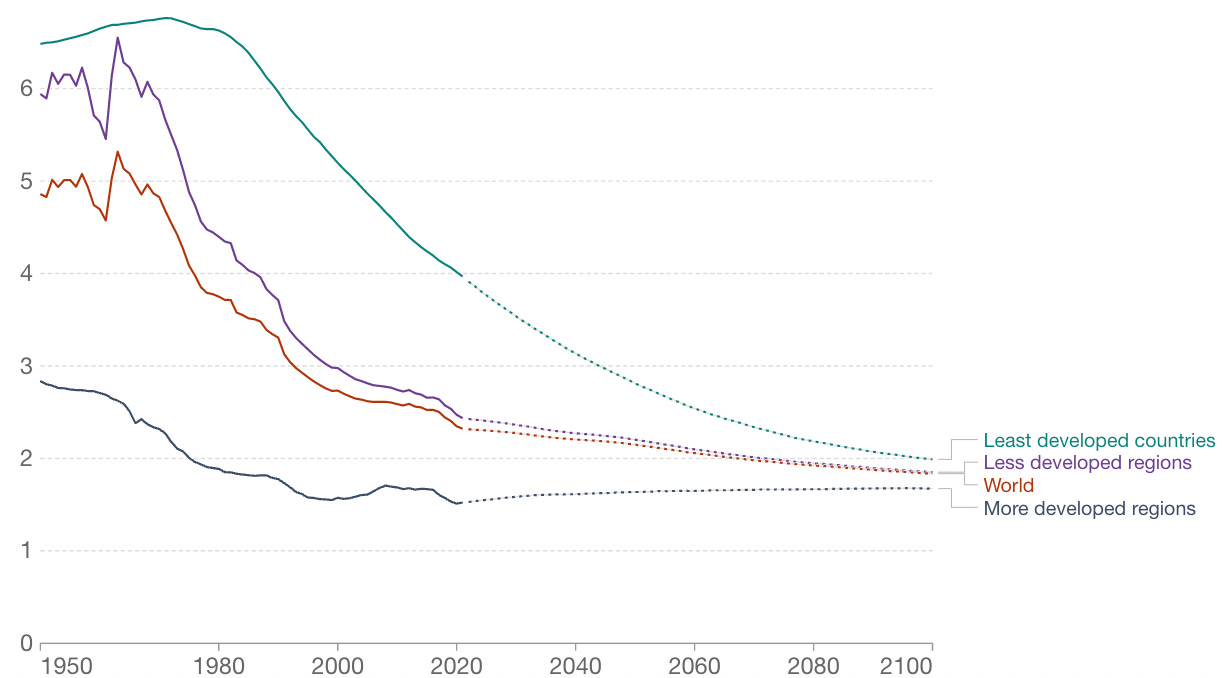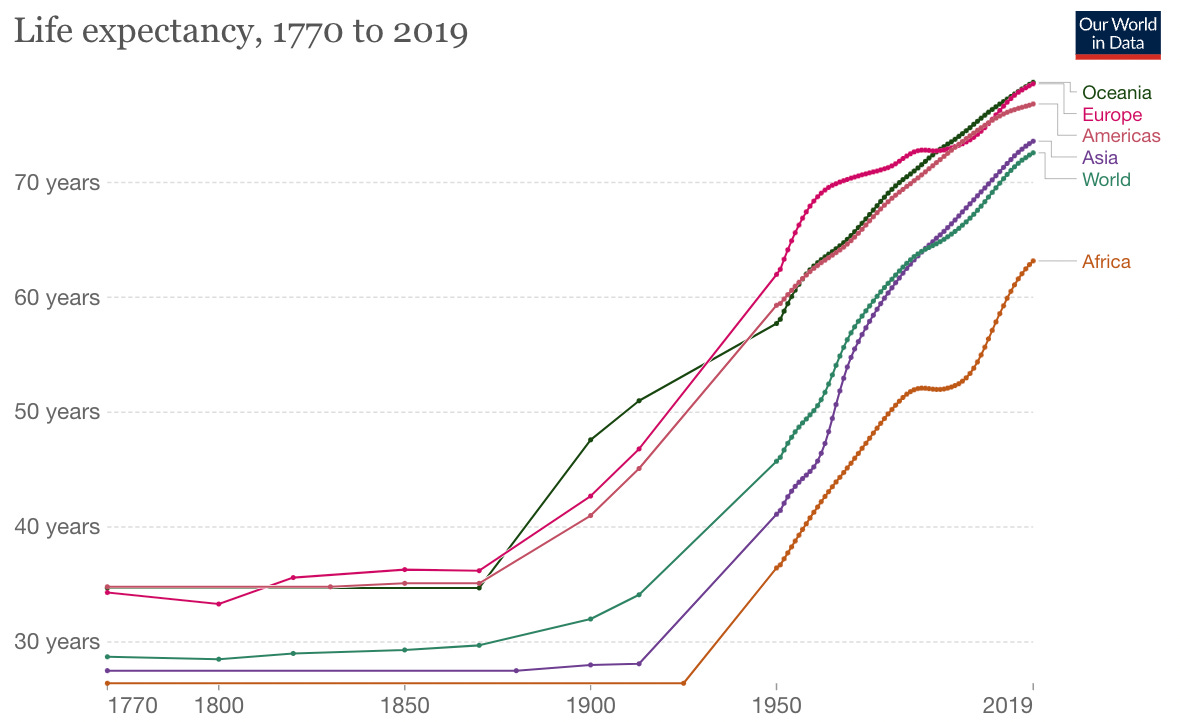On November 15, Moscow pounded Ukraine with missiles, a former U.S. President announced he would run again for the presidency, and the world’s population reached 8 billion. It was a busy news day but the demographic milestone is most significant, decried by some and applauded by others. Obviously, more people means more business, and is a welcome development for certain politicians, but it also puts more pressure on the planet. On the plus side, this number was reached in large measure because global life expectancy has reached 72.8 years, nine years more than was the case in 1990. This is due to the march of medicine as well as the reduction of poverty in the world’s two demographic giants – China and India. But interesting new population projections now predict that growth rates will stop sometime this century, possibly within two generations. Of course, fewer people means fewer consumers and is a prospect that has upset the world’s richest man, Elon Musk. “The world’s population is accelerating towards collapse, but few seem to notice or care,” tweeted the father of nine.
“Collapse” is hardly a valid description, but he’s upset because this means fewer Teslas and rocket ship trips. But the projections are a positive development. Increases in population are driven by a combination of birth rates and longer lifespans. It’s unclear how many more years can be added to a human existence even if cures are found for cancer and other serious diseases. (There are some in Silicon Valley who believe aging is merely a disease that will be cured, but that’s another topic). The major determinant will be the continuing drop fertility rates worldwide. Based on this, the United Nations in its recent population report said, between 1950 and today, population grew between 1 and 2 per cent each year, resulting in an increase from 2.5 billon to 8 billion. It then extrapolated that by the late 2080s, the population will peak at 10.4 billion, then grow slowly until increases halt altogether by 2100.
Another more comprehensive forecast, by the Wittgenstein Center for Demography and Global Human Capital, predicts a bigger drop in numbers will happen sooner. It estimated that the world’s population will peak in 2070 at 9.67 billion, then begin to rapidly decline. The difference between the two projections is that Wittgenstein baked into its model, unlike the United Nations, the most important factor which is the educational level of females. This is key, because for years and in all societies, the figures have demonstrated that the more schooling a woman gets, the fewer children she has.
The numbers affect business but also governments. As The Wall Street Journal noted “the world’s major demographic problems won’t stem from the growing masses but from shrinking countries, aging populations, and dwindling workforces.” The challenges are already hitting developed nations which now have huge cohorts of elderly people who require more medical services and fewer children requiring education services. One study projected that the number of under-fives globally will fall from 681 million in 2017 to 401 million in 2100 while the number of over 80-year-olds will soar from 141 million in 2017 to 866 million in 2100. Adjustments will be difficult and costly but conversely, so are those that have to be undertaken when growth rates are meteoric in developing countries. High birth rates hold them back, making it more difficult to eradicate poverty, combat hunger, pollution, diseases, and malnutrition or to provide the health and education benefits.
Low or no population growth will require adjustments but welcome ones, especially to those concerned about environmental degradation, pollution, and increasingly scarce resources. And several countries have already demonstrated that a drop-in-pop doesn’t necessarily slow economic growth. Some have adjusted by adopting liberal immigration policies to mitigate manpower issues, but this won’t work as the world approaches a situation where nearly every nation will be shrinking in size. So other adjustments – attitudinally and politically – will be required.
For a look at the Brave New World of Demographics, Japan provides the template for success. Its economic miracle continues and is remarkable given that the country is running out of people. With a population of 127 million, its birthrate is one of the world’s lowest and falling, its workforce shrinks as its population ages, and the Japanese disdain immigration to gain workers. To overcome this, Japan has outsourced manufacturing to other countries and has figured out how to turn its labor shortage into a competitive triumph: Japan leads the world’s revolution in automation and robotics with a dizzying array of machines that are transforming home life, work, and services of all kinds.
Another example of success is Germany. Only 10 per cent of its population is between 15 and 24 years of age, below the European average. But its overall population has grown to 83.2 million, due mostly to an influx of refugees and migrant workers. This has sometimes created social problems but has contributed to its continuing prosperity. Most importantly, Germans embrace environmentalism which is why some German leaders proudly describe their long-term demographic decline as a positive “steady-state economy” that is more environmentally sustainable and desirable than those where population and economic growth are goals.
Interestingly, low birthrates and longevity now “afflict” China, thanks to its emphasis on education and its one-child policy that helped lift its masses into the middle class in just two generations. But now the country faces a future demographic challenge due to its inordinately large number of elderly. To counteract this, the one-child policy has not only been scrapped but replaced with government incentives to encourage women to have two or more children. This is also the case in Hungary which is demographically disappearing, as are some other European countries. But so far, there’s little evidence as to whether these baby bonuses will reverse low-birth trend.
It’s also fair to predict that population figures may actually collapse faster. That’s because India is finally educating all of its females and considering the adoption of a one-child policy, either by edict or through incentives. Its birthrates have declined, but remain high, and this year India overtook China as the world’s most populous nation, each with 1.4 billion people. Now New Delhi aims to overtake China economically as it has overtaken the United Kingdom this year. India is now the world’s fifth biggest economy and its increasingly educated females will increase its wealth, and their own, by working and having fewer children.
Of course, there are caveats to any forecasts. Unpredictable factors such as the level of violence in societies, wars, a major asteroid collision, or a super virus that cannot be eradicated for years can occur. This latter hazard may be why a 2020 study published by The Lancet from researchers funded by the Global Burden of Disease Study took illness into consideration and projected that world population would peak in 2064 at 9.7 billion and then decline to 8.8 billion by 2100, or a tad more than is now the case.
Another population determinant is cultural. Polls in the United States and other developed countries show that most “Generation Zs” (those under 25 years of age) and “Millennials” (those under 42 years of age) intend to be “child free” unlike their antecedents. Seven out of 10 Generation Zs in America told pollsters they will adopt a pet rather than have children. Many cited their concern about climate change was a reason for not wanting to start a family.
Economics or politics aside, the challenge of coping with a world, or a country, that contains fewer human beings is immensely preferable to the alternative. The world is already too crowded and contaminated. Too many females are condemned to a life of poverty for lack of education and because they are burdened with too many children. The dangers inherent in unbridled growth were well articulated years ago by science fiction and futurist Isaac Asimov: “Democracy cannot survive overpopulation. Human dignity cannot survive it. Convenience and decency cannot survive it. As you put more and more people into the world, the value of life not only declines, but it disappears. It doesn’t matter if someone dies.”







When I see ariel views of cities in USA (New York), Pakistan, India, China etc. there is NO life for other species due to concrete and clay. Mother Earth can only sustain so much - and we humans are guilty of destroying so much habitat in the name of progress. Shameful actions on our part. Diseases will continue to plague us due to the overcrowding and some VERY unsanitary living conditions we humans live in.
I feel Japan is setting the future population protocol today. I agree that as more women join the work force around the world to offset the worker shortages, the birth rates will begin further declines. As more pension plans are introduced, birth rates will fall. You will no longer need children to support your old age. Education will also reduce birth rates. All of these issues suggest our population has reached close to its peak.